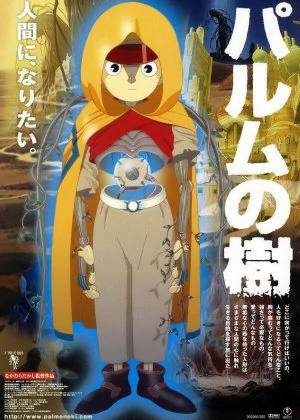A Tree of Palme
The early 2000s were a great time for anime. It wasn't a TV-dominated market just yet, international recognition was on the rise and there was a real incentive to spend money on more daring, off-kilter film projects. Takashi Nakamura's A Tree of Palme [Parumu no Ki] was such a project. It's almost impossible to imagine a film like this being made nowadays, no doubt a disappointing evolution. A Tree of Palme left quite a big impression the first time I watched it, but those memories have started to slip over time. No doubt a perfect reason to give it another go and experience the wonders of this film all over again.
![screen capture of A Tree of Palme [Parumu no Ki]](/thumbs/img/articles/1200xauto/tree-palme-1.webp)
A Tree of Palme is not a very easy sell though. A quick glance will have you believe this film is a fun fantasy adventure, aimed at younger children. With its Pinocchio-like premise, its somewhat childish art style and an army of comic relief side-characters, it looks a bit like a weird, Japanese Disney knock-off. But upon further inspection you'll start noticing a pretty wild and elaborate fantastical setting, unique creature designs, a surprisingly dark plot and a vintage anime finale (i.e. one that boggles the mind). Not to mention a film that runs over two hours long, so you have to go full-in if you have any hopes of enjoying this one.
This tension between childish and mature elements isn't exactly new for anime of course. There have been other extremes, like Rintaro's Metropolis or Shoji Kawamori's Spring & Chaos, but none quite as outspoken and deceptive as here I think. The serious tone clearly dominates this film, with only some sparse interludes of secondary characters keeping the child-like nature of the film alive. All this only to make sure you won't expect a simple, entertaining fantasy adventure, instead you should brace yourself for a more sullen and dark quest of a wooden puppet wanting to become human.
The story follows Palme, a robot built from the wood of a special tree. His creator constructed Palme to keep his daughter company, once she passes away though Palme is left without function and goes into standby mode. When he wakes up again, a ghost-like lady sends him on a quest to the underworld, where Palme hopes to become human. It's a long and perilous trip and many people are out to capture Palme and the treasures he holds inside him, but Palme's friends will be right beside him, to keep him company and to keep him out of harm's way.
![screen capture of A Tree of Palme [Parumu no Ki]](/thumbs/img/articles/1200xauto/tree-palme-2.webp)
A Tree of Palme was developed by a smaller studio, which shows in the animation quality. Not that it's bad or lacking, on the contrary, but a lengthy and fantasy-heavy film like this needs a hefty budget and it's clear that the money just wasn't always there. Animation-wise it can't quite compete with the more prestigious anime films of that era, but Nakamura picks his battles well. And whatever is skimped on the animation is returned in imaginative designs and a classic but beautiful art style. Overall the film looks stunning and immersive, with a little CG left and right to help out with the more complex designs. No doubt Nakamura's experience as an animator on various illustrious projects (including Akira, Robot Carnival and Neo-Tokyo) helped him out a lot here.
The soundtrack too is an asset to the film. Nothing overtly original, but very stylishly executed. The music supports the perilous adventure of Palme to perfection, with some ethereal-sounding music to underline the more dramatic scenes. The score moves smartly between more epic and more toned down moments and while it never really hogs too much attention, it does manage to stand out when it matters the most. It's not an exemplary score, nor does it push any boundaries, but it's quality nonetheless. As for the dub, I didn't even bother to try the English version (apart from the trailer), I think it's safe to say you better stick with the original dub unless you have serious issues with subtitles.
![screen capture of A Tree of Palme [Parumu no Ki]](/thumbs/img/articles/1200xauto/tree-palme-3.webp)
A Tree of Palme is a long film, then again there is a lot of ground to cover. The fantasy world isn't your typical Western fantasy and many of the fantastical elements need proper introduction. Palme's journey is also supposed to an epic one, so the extra minutes are welcomed as it allows him to travel through some additional locations. Because of the somewhat dark and sullen nature of the story though, the film does start to feel quite heavy after a while. Not everyone is going to appreciate this, personally I felt this worked in favor of the film rather than against it.
Nakamura's film is one of anime's hidden gems. While it did play at the Berlin film festival, the film didn't generate much buzz and has since slipped into obscurity. Seeing how the tone might not match people's expectations of the film, this isn't all that big of a surprise. But if you know what you're getting yourself into and you're up for a darker fairy tale, then there's plenty to enjoy here. The art style is lovely, the fantasy elements feel otherworldly and Palme's journey is grand, without ever feeling cheesy or expected, making this one of the better fantasy epics I've seen. Comes well recommended for animation fans.
